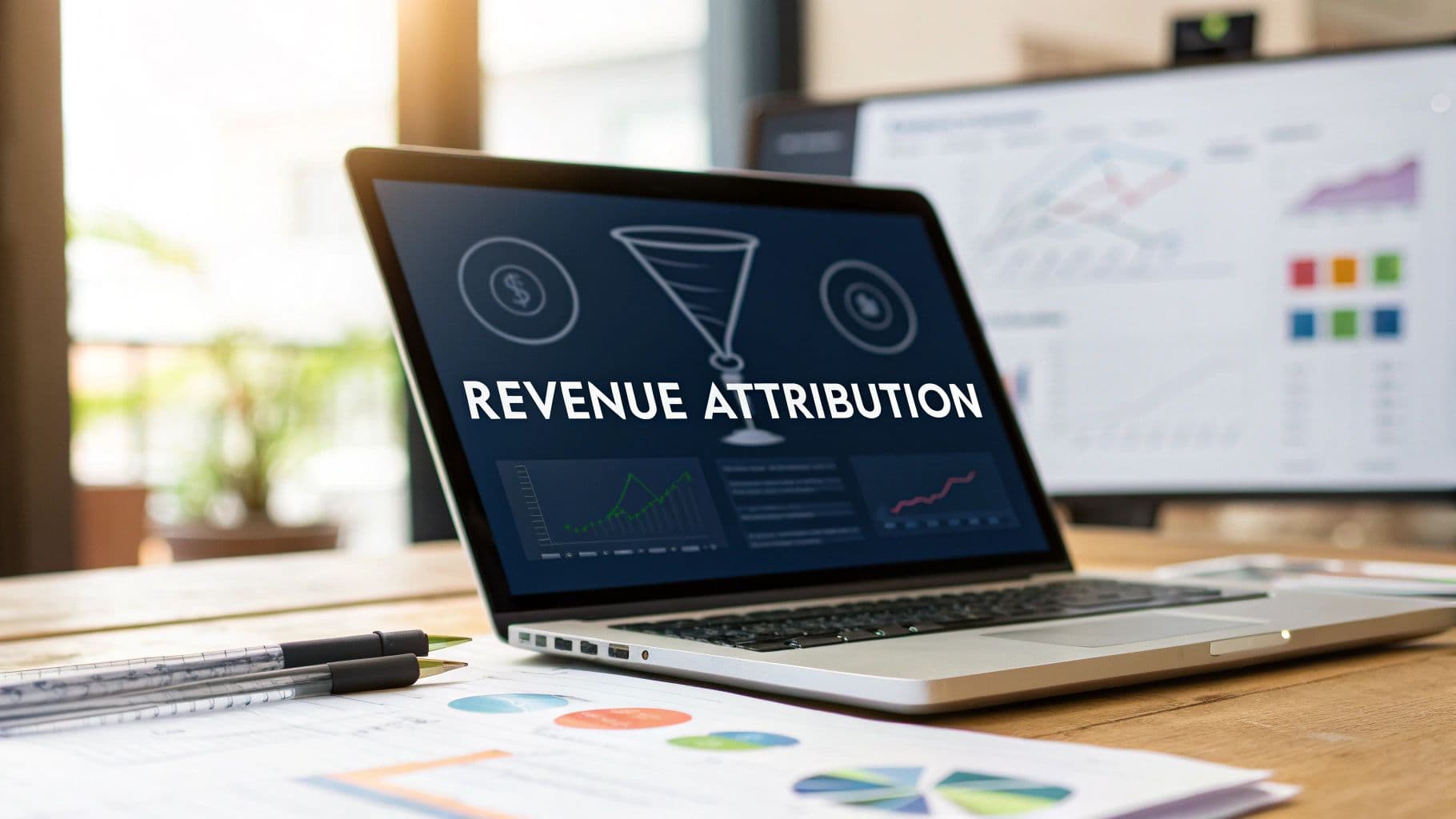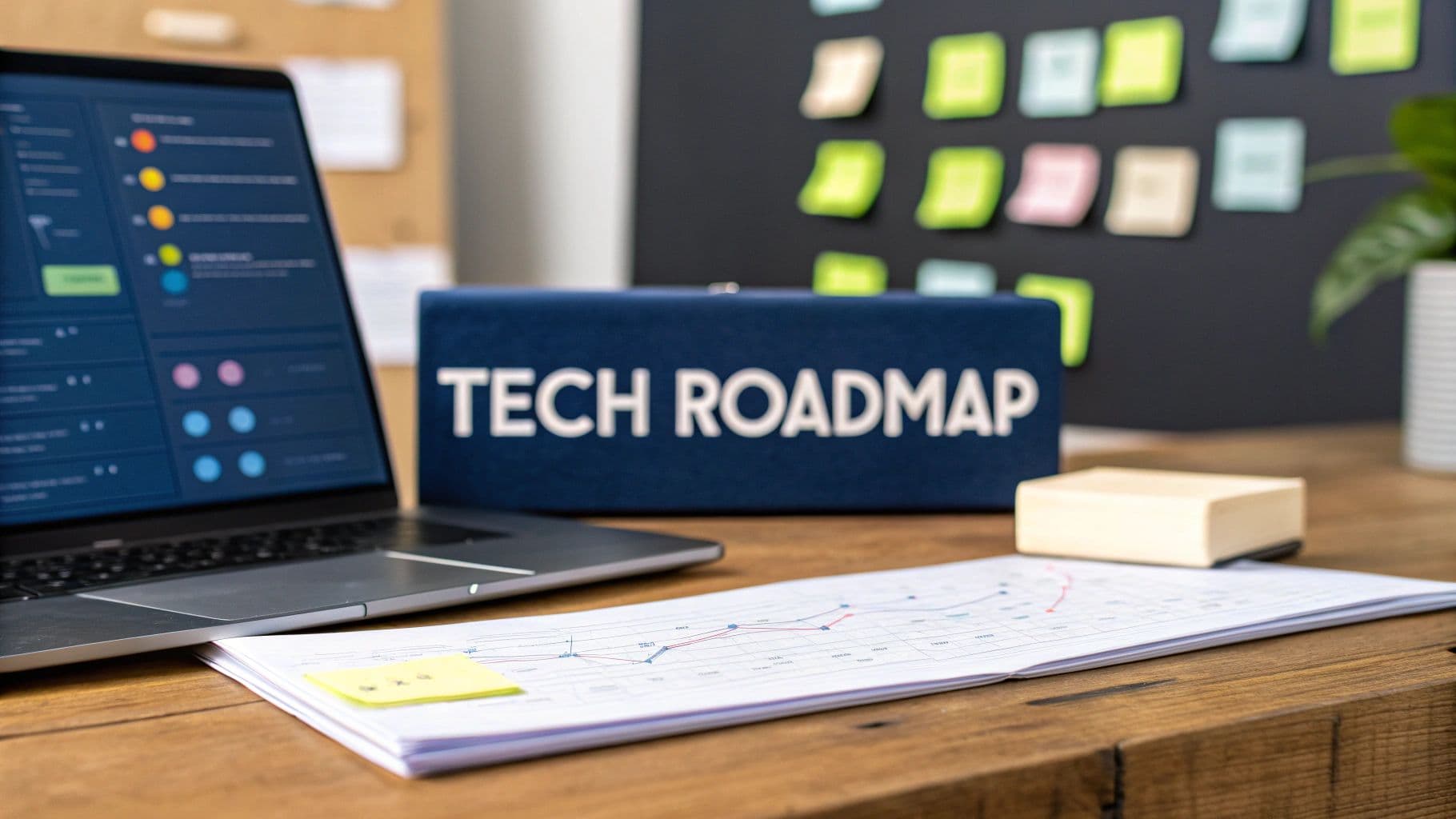A Guide to Product Led Growth Strategy
Unlock sustainable growth with this guide to product led growth (PLG). Learn core principles, key metrics, and implementation steps from real-world examples.
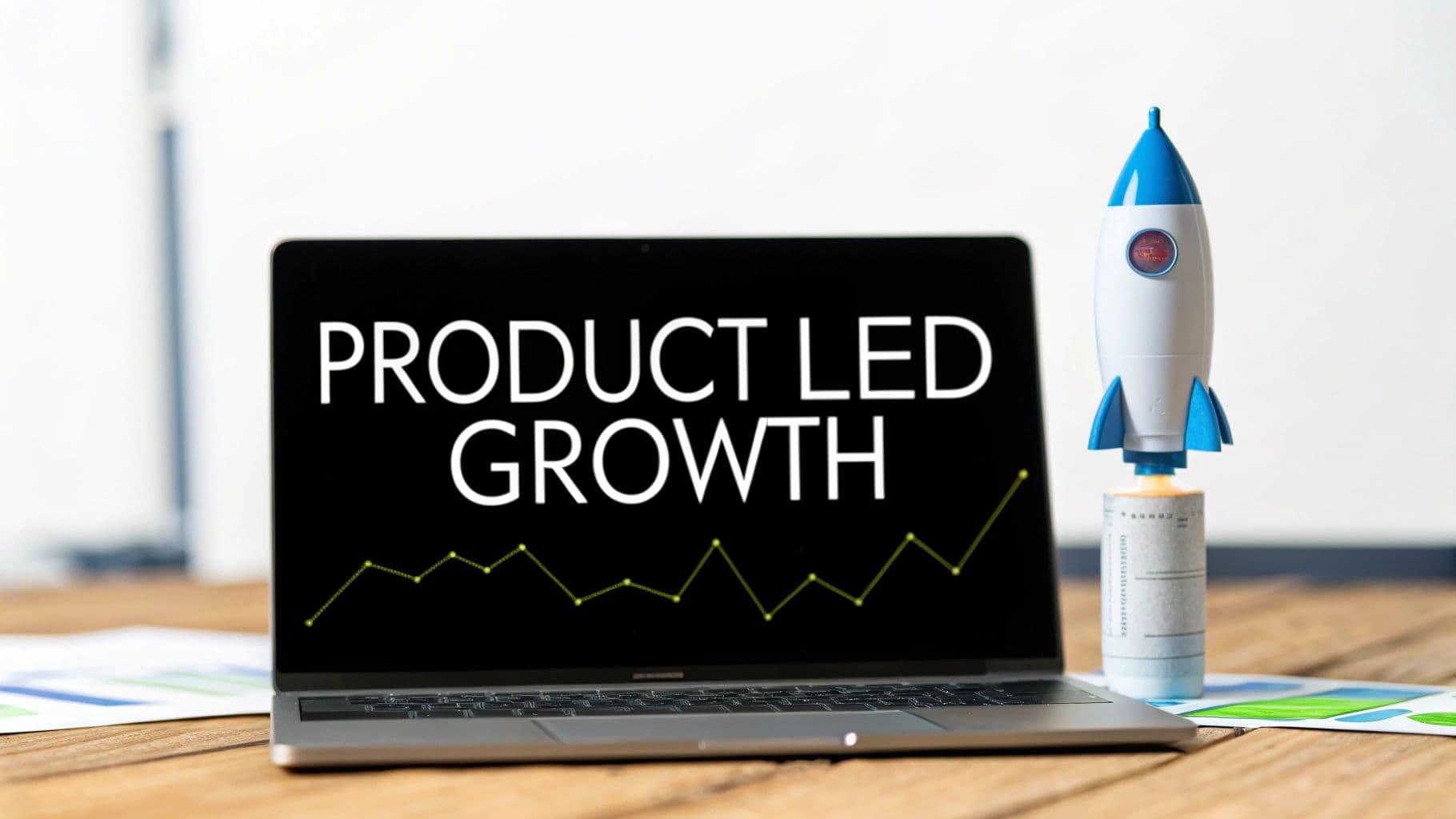
At its heart, product-led growth (PLG) is a simple idea: your product should be your best salesperson. It’s a business model where customer acquisition, expansion, and retention are all driven primarily by the product itself.
Instead of a traditional sales team knocking on doors, PLG companies let users experience the product's value directly. This usually happens through a freemium plan or a no-hassle free trial. It's about showing, not telling. This hands-on approach builds genuine trust and lets the product speak for itself.
Understanding Product Led Growth Fundamentals
Imagine you’re buying a car. In the old-school, sales-led world, a salesperson would spend an hour talking your ear off about the engine, safety ratings, and financing options before you even sit in the driver's seat.
Now, picture the product-led growth approach. The salesperson just hands you the keys and says, "Take it for a spin." You get to feel the acceleration, test the handling, and see how easily your phone syncs with the sound system. You discover the car's value on your own terms.
That’s the essence of PLG. It’s a go-to-market strategy that puts the product front and center. The goal isn't to persuade people with marketing campaigns or lengthy sales demos; it's to build a product so good that users naturally want to integrate it into their lives and work.
Shifting From Persuasion To Experience
The core philosophy is to deliver value before you ever ask for a credit card. By giving users a self-service way to get started, you empower them to solve a real problem right away. This strategy has a few defining features:
- Frictionless Onboarding: Signing up and getting started should be dead simple. The goal is to get users to their "Aha!" moment—that instant they grasp the product's core benefit—as quickly as possible.
- User-Centric Design: The entire product experience is meticulously crafted to guide people toward success. The product itself becomes the teacher, the guide, and the support system.
- Data-Driven Decisions: PLG companies live and breathe product usage data. They use it to understand what people are doing, which features they love, and where the next big opportunity for improvement lies.
The Impact of a PLG Strategy
So, what happens when a company truly commits to a product-led growth model? The results are pretty dramatic. This isn’t just some passing trend; it’s a powerful engine for business that directly strengthens the bottom line and carves out a stronger market position.
The numbers don't lie. There’s a massive performance gap between PLG companies and their more traditional peers. According to OpenView's 2023 benchmark report, top-performing product-led companies grow at an annual rate of about 50%.
That's more than double the average growth rate of traditional SaaS companies, which hovers around 21%. You can dive deeper into these product-led growth findings on TheProductManager.com. This incredible momentum comes from lower customer acquisition costs, better user retention, and the ability to scale worldwide without needing to hire a huge, expensive sales team.
Before we go further, it helps to see exactly how this model stacks up against the old way of doing things.
Product Led Growth vs Traditional Growth Models
This table breaks down the fundamental differences between Product-Led, Sales-Led, and Marketing-Led growth strategies. It highlights how each approach prioritizes different parts of the business to attract and convert customers.
| Attribute | Product Led Growth (PLG) | Sales-Led Growth (SLG) | Marketing-Led Growth (MLG) |
|---|---|---|---|
| Primary Growth Driver | The product itself; self-service experience. | Sales team; direct outreach and relationships. | Marketing campaigns; lead generation. |
| Customer Acquisition | Users sign up for a freemium or trial version. | Sales reps identify and pursue qualified leads. | Prospects fill out a form to become a Marketing Qualified Lead (MQL). |
| Entry Point | Low friction, often free. Anyone can sign up. | High friction, requires a demo or consultation. | Medium friction, requires giving contact info for content or a demo. |
| Key Metric | Product-Qualified Leads (PQLs), activation rate, time-to-value. | Customer Acquisition Cost (CAC), deal size, conversion rate. | Marketing-Qualified Leads (MQLs), Cost Per Lead (CPL), campaign ROI. |
| Target Audience | End-users and individuals within an organization. | C-level executives and key decision-makers. | A broad audience defined by demographic or firmographic data. |
| Sales Team's Role | Focuses on high-value accounts and enterprise upgrades after the product has proven its value. | Drives the entire customer journey from prospecting to close. | Nurtures leads until they are "sales-ready" and then hands them off. |
As you can see, PLG turns the traditional model on its head. Instead of marketing and sales pushing a product onto buyers, the product pulls users in by demonstrating its own value first.
The Core Pillars of a PLG Model
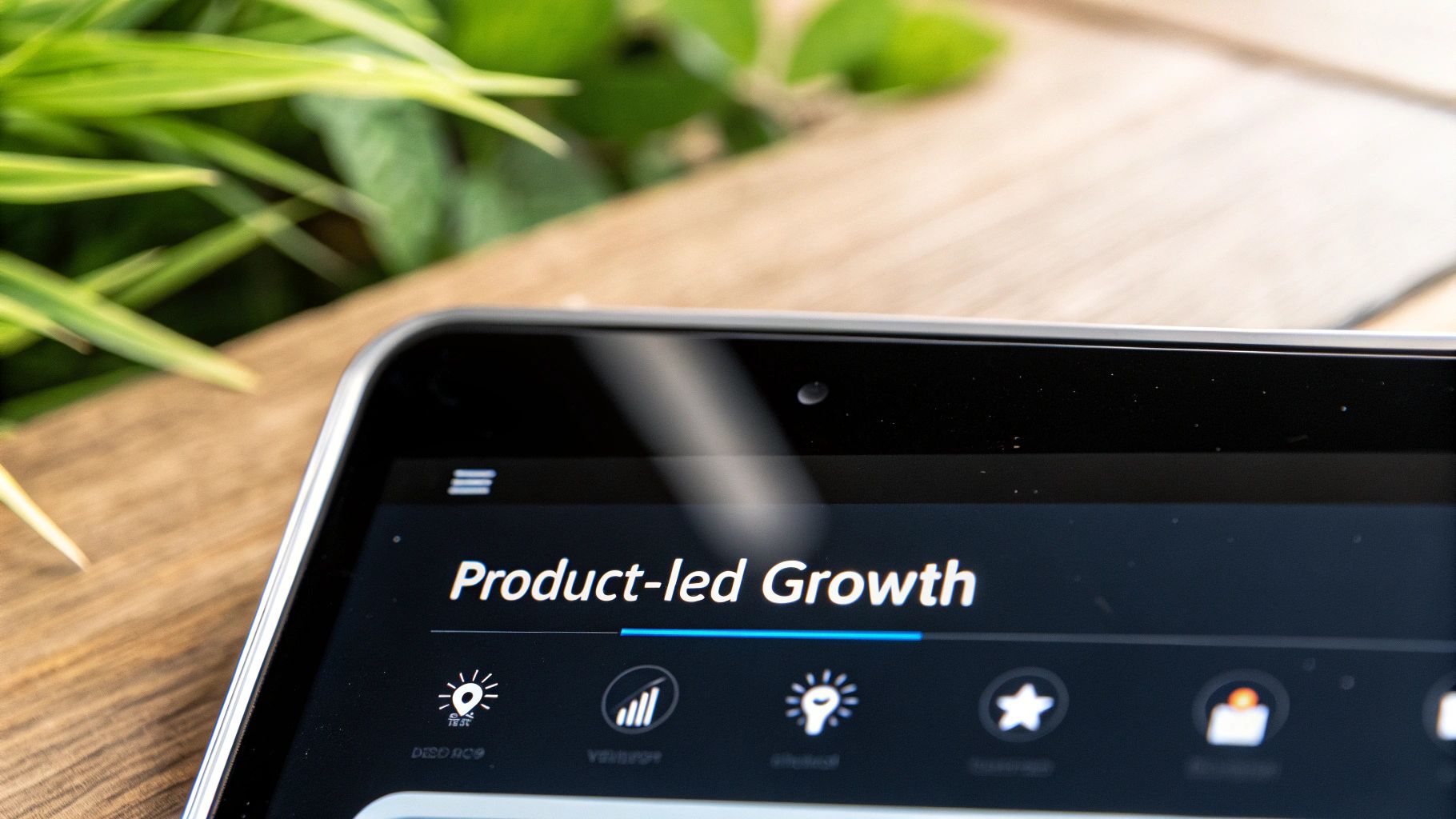
A great product-led growth strategy doesn't just happen. It’s built on a few core, user-focused ideas that work together to turn your product into your best salesperson. These aren't just buzzwords; they're the foundational beams that support the entire PLG structure.
Get one of them wrong, and the whole thing gets shaky. But get them right, and you create a powerful system where your users' success directly fuels your own.
Deliver Value Before Capturing Value
The heart of PLG is a simple, yet radical idea: be generous. Instead of putting up a paywall and asking for a credit card, you let people actually use your product and see its value for themselves. This usually takes the shape of a freemium plan or a genuinely free trial with no hoops to jump through.
This isn’t just a marketing gimmick. It's about building trust from the very first interaction. When someone solves a real problem with your tool before paying a single cent, you’ve done more than just demonstrate value—you’ve earned their confidence.
This flips the old sales model on its head. You're shifting the focus from a transaction to a relationship built on proven results, effectively removing all the risk for the buyer.
Create a Frictionless Onboarding Experience
From the moment someone signs up, the clock is ticking. You have a very small window to prove your product is worth their time. A clunky or confusing onboarding experience is the quickest way to send a potential fan running for the digital exit.
That's why the second pillar of product-led growth is an almost obsessive focus on making the first few minutes inside your product seamless, intuitive, and, frankly, delightful.
The whole point of onboarding is to rush the user to their "Aha!" moment—that magical instant where they get it. It's when the lightbulb goes on, and they see exactly how your product will make their life easier. A great onboarding flow feels less like a setup checklist and more like a guided journey to an immediate win.
To nail this, PLG companies focus on:
- Simplicity: Tearing down every unnecessary field, step, or click in the sign-up and setup process.
- Guidance: Using smart, contextual tooltips and short tutorials to show people what to do next, right when they need it.
- Quick Wins: Engineering the initial experience so a new user can accomplish something valuable in just a few minutes.
Think of it like the tutorial level of a great video game. It doesn't hand you a dense manual; it teaches you how to play by letting you play. Your product should do the same.
Leverage Product Usage Data for Insights
This third pillar is the brains of the operation. In a PLG model, you don’t have to guess what your users want or where they're struggling—you just have to watch what they do. Product usage data is the lifeblood of the strategy, giving you a direct, unfiltered look at how people actually interact with your tool.
We're talking about more than just surface-level metrics like daily sign-ups. The best PLG companies dig deep into user behavior. They track which features drive long-term retention, what sequence of actions signals someone is ready to upgrade, and where people are getting stuck and dropping off.
This firehose of data feeds a constant improvement loop.
Engineering knows which features actually matter to users. Marketing learns to talk about the benefits people truly love. And sales can pinpoint Product-Qualified Leads (PQLs)—users whose in-app behavior screams "I'm ready to buy!" This data-driven approach keeps the product evolving right alongside the needs of your users, creating a powerful, self-reinforcing cycle of growth.
Why PLG Is Winning in the SaaS Market

The explosive growth of the product-led growth model isn't just another industry fad. It's a fundamental shift, born directly from how modern customers want to buy software. Gone are the days when buyers were content to sit through a lengthy sales pitch; today, they want to get their hands dirty, try things out for themselves, and see the value before ever pulling out a credit card.
PLG taps directly into this "try before you buy" mindset, making it a more natural and effective way to grow. By putting the product front and center, companies can build a healthier, more sustainable business from the inside out. They rely less on massive sales and marketing budgets, which translates to a much stronger bottom line.
Lower Customer Acquisition Costs
Let’s talk about one of the biggest wins with PLG: its effect on Customer Acquisition Cost (CAC). In the old sales-led world, getting a new customer on board was a pricey, hands-on affair. It involved a whole chain of marketing campaigns, sales reps, and account executives just to get a signature.
A product-led growth strategy completely flips that script. Here, the product itself is your best acquisition tool. A smooth, no-friction freemium plan or a free trial can bring in thousands of potential customers for a tiny fraction of what traditional marketing would cost.
This kind of efficiency is a game-changer. It means you can grow much faster without needing huge injections of cash to fuel your sales and marketing machine. Your product essentially becomes a self-powering lead generation engine.
Faster Growth Cycles and Higher Retention
Think about it: when users have already experienced your product's "aha!" moment before they're asked to pay, the sales cycle shrinks dramatically. There are no long, drawn-out negotiations. Upgrading just becomes the logical next step for someone who already depends on your tool. This self-service motion puts the entire revenue cycle on fast-forward.
Even better, customers who come in through a PLG motion tend to stick around longer. They’ve already kicked the tires, integrated the product into their daily work, and confirmed it solves a real problem for them. This creates incredible customer loyalty and higher net revenue retention for a few key reasons:
- It’s a Better Fit: These users chose you. They self-selected, which means your product is almost certainly the right solution for their needs.
- They’re More Engaged: They’ve already mastered the basics and are far more likely to explore advanced features and get even more value.
- Expansion Happens Naturally: A happy user quickly becomes a champion inside their own company, spreading the word to other teams and driving organic growth.
The numbers don't lie. According to Bain's 2023 Technology Report, software companies with a solid PLG strategy saw revenue grow in 2022 at nearly twice the rate of those without one. They were also almost three times more likely to grab more market share. You can dig deeper into how enterprise sales supercharge product led growth on Bain.com.
Built for Scalability
Finally, the self-service foundation of PLG is built to scale. A sales-led company can only grow as fast as it can hire and train new salespeople. But a product-led company? It can sign up and onboard new users from anywhere in the world, 24/7, without a single human getting involved.
This global, always-on model allows PLG businesses to break into new markets and scale internationally with far less friction and upfront investment. The product becomes your round-the-clock, worldwide sales engine—and that’s a business case that founders and investors are finding impossible to ignore.
How User Experience Drives Product-Led Growth
In the old sales-led world, a slick salesperson could work magic. They could demo a clunky product, gloss over its flaws, and sell the dream of what it could be one day. With product-led growth (PLG), that's impossible. There’s nowhere to hide.
The product is the salesperson. It’s also the onboarding specialist and the first line of customer support, all wrapped into one. If that experience is confusing or frustrating, your salesperson is falling flat on its face. This is why user experience (UX) isn't just a nice-to-have in a PLG strategy; it's the whole engine. Every click and interaction is a make-or-break moment where a user decides to stick around or bounce forever.
Minimizing Friction From the First Click
The journey starts the second someone hits your signup page. Any friction here—too many questions, a clunky verification step, confusing instructions—is like putting a velvet rope in front of your store's entrance. You want people to glide right in. The goal is to make getting started feel completely effortless.
Look at companies like Slack or Notion. Their signup process is legendary for its simplicity. They ask for an email, and you're in. They don’t interrogate you about company size or budget right away. They know the only thing that matters at that moment is getting you into the product and one step closer to that first win.
Designing for the All-Important "Aha!" Moment
Once someone is inside your product, the clock starts ticking. You're in a race to get them to their "Aha!" moment—that magical instant where they get it. It’s the point where they see how your product solves their specific problem and can’t imagine going back. A killer user experience is all about shortening this Time to Value (TTV) by steering users directly toward that outcome.
You can pull this off with a few smart UX tactics:
- Guided Onboarding: Ditch the long, boring product tour nobody reads. Instead, use interactive tooltips and checklists that pop up right when they’re needed, teaching users by getting them to do something meaningful.
- Smart Empty States: A blank dashboard is intimidating. Great UX design treats this "empty state" as an opportunity, offering up templates, suggestions, or a clear "start here" button. It turns a moment of potential confusion into a launchpad.
- Intuitive Layout: Your product should just make sense. Users shouldn't have to hunt for features. When things are exactly where people expect them to be, it creates a feeling of effortless control.
Creating Feedback Loops for Continuous Improvement
Finally, a well-designed product in a PLG model is a goldmine of data. User experience research isn’t a one-and-done project. It’s a constant conversation with your users, told through their clicks, hesitations, and favorite features. By tracking what people actually do, you can see exactly where they get stuck, which features they ignore, and which ones they love.
This approach lets your product team make decisions based on hard evidence, not just hunches. The insights you get from watching how people interact with the product feed right back into the design process. It creates a powerful cycle where the product is always evolving to be better and more aligned with what users need.
And this obsession with UX really pays off. The data shows that companies with a strong PLG focus see a 63% faster growth rate than their peers. That boost comes directly from designing a product that resonates with users, powered by constant feedback and smart UX. To dig deeper, check out this guide on the link between UX and product-led growth on Userlytics.com. In the end, investing in UX is a direct investment in your company’s growth.
Key Metrics to Measure PLG Success
If you're coming from a traditional sales-led background, you're used to measuring success by the number of leads in the pipeline and deals closed. But in the world of product led growth, those numbers barely scratch the surface. You can't improve what you don't measure, and tracking the right data is the only way to know if your product is actually the engine of your growth.
It's easy to get distracted by vanity metrics. A million signups sounds impressive, but it means absolutely nothing if those users log in once and never come back. PLG forces you to focus on metrics that prove people are getting real, tangible value from your product. These are the numbers that show your product isn't just being tried—it's being adopted.
Moving Beyond Vanity Metrics
The first real shift is moving your focus away from top-of-funnel noise and toward what people are doing inside your product. You start tracking the specific actions that correlate with long-term retention and, eventually, revenue. Think of these metrics as a health check for your growth engine, showing you precisely what's working and where friction is causing users to give up and leave.
This data-first mindset lets you build a dashboard that reflects the true momentum of your business. When everyone from product to marketing is aligned on these core metrics, the entire company stays focused on a single goal: creating a fantastic user experience.
The results of this focus can be dramatic, creating a powerful domino effect across the entire user journey—from better conversion to higher retention.
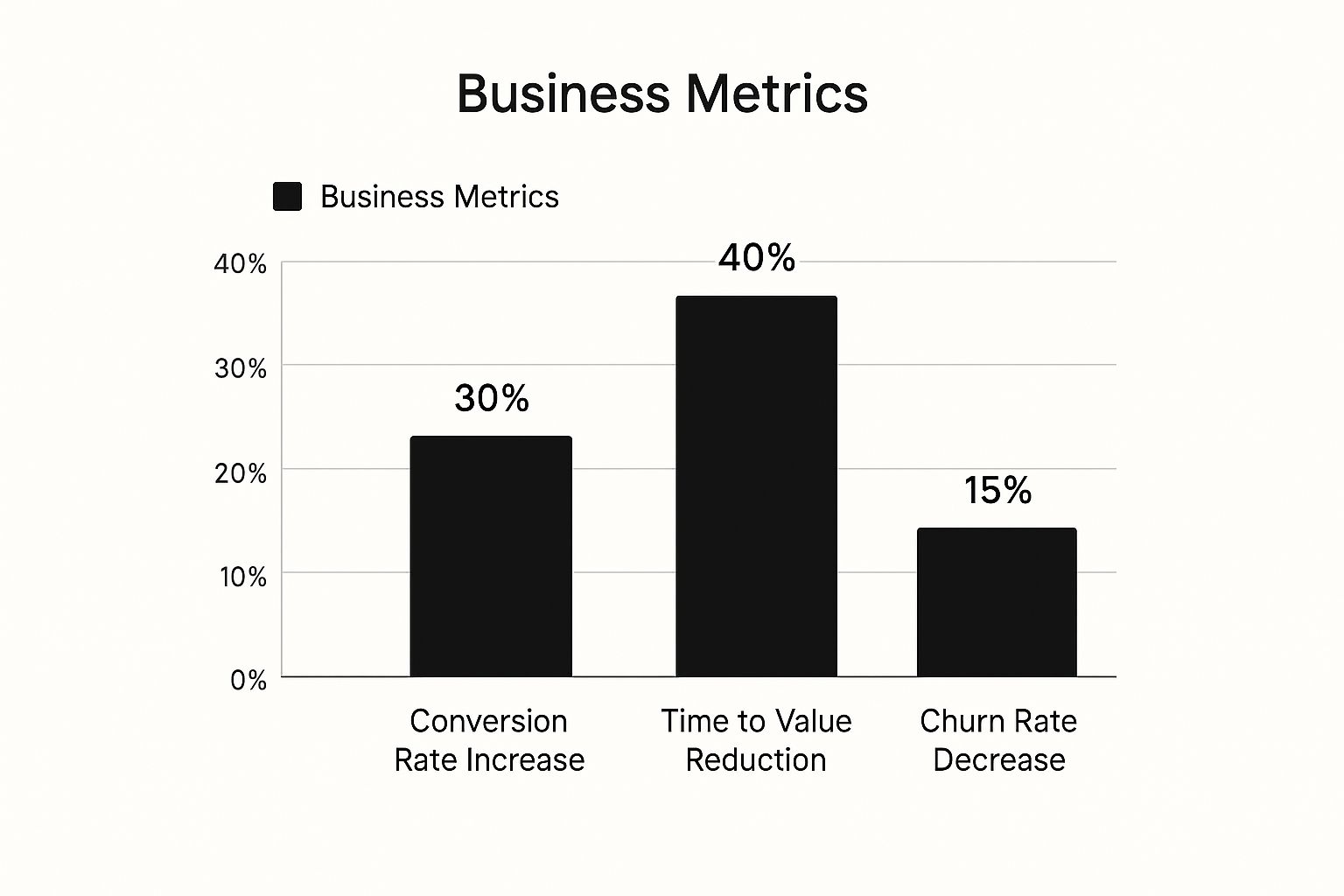
As you can see, a well-measured PLG strategy builds on itself, delivering compounding returns in user value and business growth.
The Metrics That Really Matter
To get a clear picture of your product's performance, you don't need dozens of charts. You just need to concentrate on a handful of key indicators that tell a compelling story about your user's journey.
Here are the essentials:
- Time to Value (TTV): How long does it take for a brand-new user to experience that "Aha!" moment? This is the point where they truly grasp your product's core benefit. A short TTV is one of the strongest predictors of long-term stickiness.
- Activation Rate: Activation isn't just a signup. It's the percentage of users who complete a critical action (or set of actions) that signals they're hooked. Defining this milestone is a non-negotiable for any PLG company.
- Product-Qualified Leads (PQLs): This is a game-changer. A PQL is a user whose actions within the product signal they're ready for an upgrade or a conversation with sales. It's infinitely more powerful than a lead who just downloaded a whitepaper.
- Expansion Revenue: This is the money you make from existing customers through upgrades, add-ons, or new features. Often called "negative churn," strong expansion revenue is the ultimate proof that your product delivers compounding value over time.
To truly understand what makes a product-led approach so effective, it's helpful to break down the key metrics that drive its success. The table below outlines the most important metrics you should have on your PLG dashboard.
Essential Product Led Growth Metrics
| Metric | What It Measures | Why It's Critical for PLG |
|---|---|---|
| Time to Value (TTV) | The time it takes a new user to realize the product's core benefit or "Aha!" moment. | A shorter TTV means users get hooked faster, drastically reducing churn and increasing adoption. |
| Activation Rate | The percentage of users who complete a predefined set of key actions early in their journey. | This metric separates engaged users from passive signups, showing if your onboarding is effective. |
| Product-Qualified Leads (PQLs) | Users who have hit usage-based milestones that indicate they are ready to buy or upgrade. | PQLs are high-intent leads generated by product value, leading to more efficient sales cycles. |
| Expansion Revenue | Revenue generated from existing customers through upgrades, cross-sells, or add-ons. | This is the hallmark of a successful PLG strategy, proving your product's value grows over time. |
| Customer Lifetime Value (CLV) | The total revenue a business can expect from a single customer account throughout their relationship. | In PLG, a high CLV indicates strong retention and successful expansion revenue strategies. |
| Net Promoter Score (NPS) | A measure of customer loyalty and satisfaction based on how likely they are to recommend your product. | High NPS scores often correlate with organic, word-of-mouth growth, a key driver for PLG. |
Tracking these metrics gives your team a shared language and a clear, data-backed view of how well your product is performing as the primary driver of growth.
A New Breed of Lead: PQLs vs. MQLs & SQLs
To grasp the power of a PQL, you have to see how it stacks up against the old-school leads we're all familiar with. The traditional model was a clunky, linear handoff process.
A Marketing-Qualified Lead (MQL) is someone who simply interacted with your marketing materials, like downloading an ebook. Their intent is usually educational, not commercial. They're curious, not committed.
A Sales-Qualified Lead (SQL) is an MQL that a sales rep has vetted and decided is worth pursuing. But this qualification is still based on conversations and assumptions, not on actual product experience.
Then there's the Product-Qualified Lead (PQL). This person has already used your product to achieve something valuable. They don't need to be sold on its worth—they've already experienced it firsthand. This simple fact makes the PQL the most valuable, high-intent lead you can possibly get, directly tying your product's success to your bottom line.
How to Implement a PLG Framework
Switching to a product-led growth model isn't like flipping a switch. It's a fundamental shift in how your company operates, and it demands a deliberate, step-by-step approach that puts your product at the very center of your growth engine. Making this work means moving beyond the buzzwords and laying a solid foundation with every team aligned on a new, user-first mission.
The whole process starts by getting back to basics. You have to nail down your product's core value proposition. Forget the marketing fluff for a moment and ask: What is the one critical problem we solve better than anyone else? This is the bedrock promise your product makes to its users.
Once you know that, your next job is to pinpoint the "Aha!" moment. This is that magical instant when a new user gets it—they experience your core value firsthand and understand exactly how your product will make their life better. From this point forward, every single decision should be laser-focused on getting new users to that moment as fast as humanly possible.
Re-Engineering the User Journey
With your core value and "Aha!" moment clearly defined, it's time to rebuild the entire user experience around self-service. This means being absolutely ruthless in cutting out any friction—every unnecessary form field, every confusing bit of jargon, every single step that gets between a user and that first taste of success.
This is all about data-driven optimization. You need to understand exactly how people behave inside your product, and a platform like SigOS is invaluable for this. It digs into user feedback and behavioral data to show you precisely where people are getting stuck or dropping off. When you can see the friction points, you can make smart changes to shorten the Time to Value (TTV).
Think of it as a four-step cycle:
- Map the Current Journey: Lay out every single action a new user takes, from the second they sign up to their first meaningful interaction.
- Identify Friction Points: Dive into your product analytics and user feedback. Where do people get confused? Where do they give up?
- Simplify and Automate: Kill unnecessary steps. Build in helpful guidance like checklists or interactive tooltips that lead users toward their goal.
- Test and Iterate: Constantly run A/B tests on your onboarding. Small tweaks can have a massive impact on your activation rate, so never stop experimenting.
A successful PLG framework treats the user's first experience not as a setup process, but as the most important part of the product. It’s your one chance to prove your worth, and every second counts.
Aligning the Entire Organization
Let's be clear: product-led growth will fail if it's treated like just another project for the product team. It demands a company-wide cultural shift where product, engineering, marketing, and sales all rally around the same product-centric goals. The old departmental silos have to come down.
For marketing, the primary goal shifts from generating MQLs to driving signups for your free or trial version. Sales stops chasing cold leads and starts engaging with highly qualified users—Product-Qualified Leads (PQLs)—who have already shown they're serious through their actions inside the product.
This kind of alignment creates a seamless journey that smoothly guides a user from discovering your product to becoming an active, paying customer. The product itself becomes the common ground, fueling a unified push for growth that is both sustainable and driven by real user value.
Common Questions About Product-Led Growth

Anytime a company starts exploring a product-led growth strategy, a handful of questions and misconceptions pop up. It’s only natural. When you’re moving away from a traditional sales model that’s been the standard for decades, you're bound to run into some uncertainty.
Let’s clear the air and tackle some of the most common questions head-on.
Can PLG Work for Complex Enterprise Products?
There's a persistent myth that PLG is just for simple, low-cost apps. And while it's true that a purely self-serve model is a tough sell for highly complex enterprise software, that doesn't mean PLG principles don't apply. The trick is to blend models.
Many of the most successful enterprise companies use a product-led motion to get a foot in the door. They might offer a free version or a trial that solves one specific, nagging problem for a user or a small team. Once the product proves its value and creates internal champions, a high-touch sales team can step in to navigate the enterprise deal's complexities, like security reviews, procurement, and custom contracts.
The product becomes the beachhead. It proves its worth from the bottom up, so the sales team can build on that momentum to close bigger, more strategic deals. It’s the best of both worlds.
Does PLG Eliminate the Sales Team?
This is probably the biggest misconception out there. Product-led growth doesn't make your sales team obsolete—it makes them smarter. Their role just shifts from being a gatekeeper to becoming a strategic guide.
Instead of spending their days chasing cold leads and running basic demos, the sales team gets to focus on Product-Qualified Leads (PQLs). These are people who have already used the product, experienced that "aha!" moment, and are showing signs they’re ready for more. This frees up sales to have much more meaningful conversations about expansion and strategic value.
What Are the Biggest Transition Challenges?
Switching to a PLG model is a major change, and it’s about a lot more than just launching a free trial. The toughest obstacles are almost always internal and cultural.
Three challenges tend to stand out:
- Overcoming Cultural Resistance: Getting an entire company to shift from a sales-first to a product-first mindset is a huge undertaking. For a quota-driven sales culture, learning to put user success before everything else can be a difficult adjustment.
- Breaking Down Departmental Silos: PLG requires your teams to be in lockstep. Marketing, sales, product, and engineering can’t work in their own little worlds anymore. They have to function as one unified growth team, all focused on the same product metrics.
- Implementing Robust Product Analytics: You can't just guess your way through a PLG strategy. It demands a solid analytics stack to understand what users are doing, spot those PQLs, and measure how quickly people find value in your product.
Getting through these hurdles is what unlocks the sustainable, efficient growth that a true product-led model can deliver.
Transforming your qualitative feedback into actionable, revenue-driving insights is critical for PLG success. SigOS helps you identify the signal in the noise, quantifying the dollar value of bugs and feature requests. Prioritize your roadmap with SigOS today.
